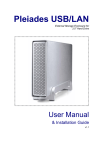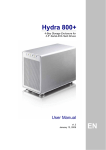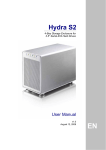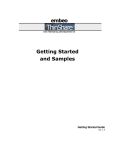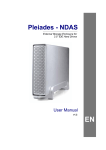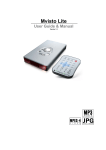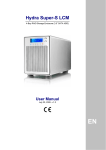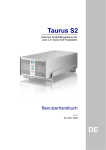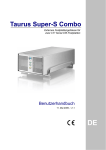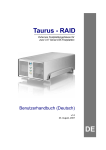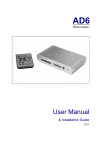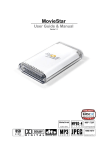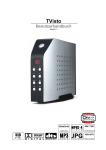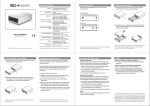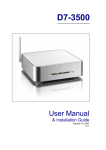Download Macpower & Tytech M9-LAN User manual
Transcript
M9-LAN Network Drive for 3.5” IDE HDD User Manual & Installation Guide v1.1 Table of Contents CHAPTER 1 - INTRODUCTION -1- CHAPTER 4 – LAN DISK SETUP - 10 - ICON KEY -1- NETWORK INSTALLATION ON A PC - 10 - THE M9-LAN -1- NETWORK INSTALLATION ON A MAC - 10 - PACKAGE CONTENTS -1- CONFIGURING THE LAN DISK - 10 - SYSTEM REQUIREMENTS -2- LOGIN ON A PC - 10 - PC REQUIREMENTS -2- LOGIN ON A MAC - 10 - MAC REQUIREMENTS -2- SYSTEM INFORMATION - 11 - INTERFACE INFORMATION -2- MAINTENANCE - 11 - SMB SERVER - 12 - FILE ACCESS ON A PC - 12 - FILE ACCESS ON A MAC - 13 - CHAPTER - 2 INSTALLING THE HDD -3- PREPARING THE ENCLOSURE -3- FTP CONFIGURATION - 13 - HARD DRIVE ASSEMBLY -3- DISK UTILITY - 14 - TECHNICAL QUESTIONS - 15 - FAQ - 15 - ABOUT THIS MANUAL - 16 - CHAPTER 3 - SYSTEM SET UP -4- INSTALLATION ON A PC USING USB 2.0 -5- WIN2000 OR WINXP WITH USB -5- WIN98/SE WITH USB -5- UNPLUG PROCEDURE -5- INSTALLATION ON A MAC USING USB 2.0 -6- MAC OS 9.X OR MAC OS 10.X WITH USB -6- MAC OS 10.2 OR ABOVE WITH USB 2.0 -6- UNPLUG PROCEDURE -6- PARTITIONING & FORMATTING -7- PC RUNNING WIN98/SE OR WINME -7- PC RUNNING WIN2000 OR WINXP -8- MAC OS -9- Chapter 1 - Introduction Icon Key Throughout this manual you will see icons in the left margin that denote either Notes or Special Remarks as outlined below: General Notes and Tips Remarks for PC users Remarks for Mac users The M9-LAN The M9 external disk drive enclosure incorporates both USB 2.0 High Speed and LAN connections in one unit. It is a sleek and stylish enclosure for your 3.5” IDE hard drive, and its heatsink and smart fan technology ensures optimum heat dissipation. Designed specially for the modern home/office environment, the M9 offers exceptional performance and a timeless design. Product Dimensions: 16.5cm x 16.5 cm x 3.8 cm 6.50” x 6.50” x 1.50” Package Contents Package Content may vary, depending on vendor & version. • M9-LAN • External Power Adapter; Input 100-240V, Output +12V/1.5A, +5V/1.5A • USB 2.0 High Speed cable • Ethernet cable • Driver CD -1- System Requirements PC Requirements • • • • Minimum Intel Processor II 350MHz, 64MB RAM USB 1.1 equipped PC; WinME, Win2000, WinXP USB 2.0 equipped PC; WinME, Win2000, WinXP 10 Mbps, 100 Mbps or 10/100Mbps Fast Ethernet card, or a USB-to-Ethernet converter equipped PC; Win2000, WinXP Mac Requirements • • • • Minimum Apple G3 processor, 64MB RAM USB 1.1 equipped Mac; Mac OS 9.1, 9.2, 10.1.5, 10.2, 10.3 USB 2.0 equipped Mac; Mac OS 10.2, 10.3 or more 10 Mbps, 100Mbps or 10/100Mbps Fast Ethernet card, or a USB-to-Ethernet converter equipped Mac OS 9.2, 10.2 or more. Interface Information If you forget your login name or password, press and hold the reset button, turn on the device and wait for 10 seconds before releasing it. This will reset the device to its factory default settings. Front LED status lights: Red = HDD Access Amber = Network Status (LINK) Green = System (OS) X 1. 2. 3. 4. 5. 6. Y Z [ Power switch Power receptacle Switch for fan speed * 10/100 auto sensing port Reset button USB 2.0 interface -2- \ ] * Fan settings: A = Auto M = Manual H = High Speed L = Low Speed Chapter - 2 Installing the HDD Your unit might come with a preinstalled hard drive. Before opening your enclosure, please read the warranty and any other notes from your vendor carefully before doing so, as this might void your warranty. Preparing the Enclosure 1. Remove the 4 screws on the bottom of the unit. 2. Lift the top cover off the body. 3. Remove the heat sink from the enclosure. 4. Place the hard drive upside down in the heat sink. 5. Fasten the heat sink to the hard drive using four screws Ensure that the HDD jumper is set to Master. Hard Drive Assembly Be careful not to damage any cables or components and double check the connection between the cables, the bridge board and your hard drive before replacing the case cover. 1. Connect the IDE cable and the power line to your hard drive. 2. Place the hard drive into the enclosure. 3. Fasten the 4 screws on the bottom of the heat sink. 4. Attach the thermal probe with the tape provided to the spindle motor on the bottom-side of the drive. 5. Align the top cover with the body and push lightly into place. -3- Chapter 3 - System Set Up Make sure your computer is connected to the same network as your LAN disk. In LAN mode, the ‘M9-LAN’ is attached to an Ethernet switch or router. Each user on the network can use the LAN disk and access it using FTP or SMB. Do not connect the USB and Ethernet cables at the same time! In USB 2.0 High Speed mode, the ‘M9-LAN’ is directly attached to a single computer via the USB port. To assure optimum performance on the network, only use network switches and routers. A few tips on how to connect your external storage enclosure: If you buy a spare power adapter, make sure the specifications are identical with the power adapter supplied! • Do not cover the Enclosure and leave enough room around it for the drive to cool down • Do not expose the product to water or humid conditions • Always check for visible damage and defects of power and interface cables before use • We recommend using the cables and adapter supplied with your product -4- Installation on a PC using USB 2.0 Win2000 or WinXP with a USB connection: If the system doesn’t recognise the drive, turn on the power first, before connecting the USB cable. • • • • Turn on your Computer and start Windows Connect the M9 and turn it on Let Windows search and install the driver automatically Open “My Computer” to see your external hard drive ** Win98/SE with a USB connection: • • • • • Turn on your Computer and start Windows Insert the driver CD into your CD-ROM Connect the M9 and turn it on Follow the on-screen instructions and install the drivers Open “My Computer” to see your external hard drive ** Unplug Procedure: For safe removal of your drive and to assure that no data is lost, always follow the unplug procedure. Not following these instructions may lead to an error message showing up. • Click on the taskbar icon for external hardware • Choose your external hard drive and confirm to remove it ** For factory new drives and formatting, see “Partitioning & Formatting” -5- Installation on a Mac using USB 2.0 Mac OS 9.x or Mac OS 10.x with a USB connection: If the system doesn’t recognise the drive, turn on the power first, before connecting the USB cable. • • • • Turn on your computer and start Mac OS Connect the M9 and turn it on No driver installation required The external drive will mount and show up on your desktop** Mac OS 10.2 or above with a USB 2.0 connection: • • • • Turn on your computer and start Mac OS Connect the M9 and turn it on No driver installation required The external drive will mount and show up on your desktop** Unplug Procedure: • Drag the external hard drive icon into the trash bin • Turn off your device For safe removal of your drive and to assure that no data is lost, always follow the unplug procedure. Not following these instructions may lead to an error message showing up. ** For factory new drives and formatting, see “Partitioning & Formatting” -6- Partitioning & Formatting You can choose to create several partitions via USB. However please note that only the first partition will be recognised on the network (LAN disk function). Be aware that this will destroy all existing data on the drive, so make sure you have a backup! This step is usually only required the first time you install a factory new hard drive, if you change the format or want to erase all data on your drive. PC running Win98/SE or WinME: MS-DOS command “fdisk” (press Enter to confirm) • • • • • Type “fdisk” and press Enter Select ”Y” and press Enter Enter "5” to change the drive Select the drive you want to format Choose “1” and follow the onscreen instructions The drive must be formatted using the FAT32 file system. Alternatively, you can also format the LAN disk using the disk utility option. Connect the device to your LAN, login, go to disk utility and choose “Format”. -7- PC running Win2000 or WinXP: Disk Management Program The drive must be formatted using the FAT32 file system. If NTFS is used, the drive will only be recognised on USB. • Right click on “My Computer” and choose “Manage” • Select “Disk Management” • Choose the drive you want to format and right click on it for further commands (Choose New Partition) • Follow the Partition Wizard and create a FAT32 partition If you use Win2000 or WinXP and FAT32, the biggest single partition you can create will be 32GB. To create larger partitions, you need to use the DOS command under Win98SE or WinME or use 3rd party software. Alternatively, you can also format the LAN disk using the disk utility option. Connect the device to your LAN, login, go to disk utility and choose “Format”. You can choose to create several partitions through USB but be aware that only the first partition will be recognised on the network (LAN disk function). -8- Mac OS: The drive must be formatted using the FAT32 file system (MS-DOS). If Mac OS extended is used, the drive will only be recognised on USB. Mac OS9.2 and earlier, do not support creating partitions on an external drive. To perform this function, you will need additional 3rd party software, which is not supplied you’re your unit. Alternatively, you can connect the drive to the internal IDE bus or upgrade to OS X. For Mac OS X, use the Disk Utility to format and create partitions on your external disk. • Select “Disk Utility” in the utilities folder • Choose your external drive and create a FAT32 partition (also called MS-DOS on the Mac) If you can not see the drive, make sure the jumper settings of your hard drive are correct, there are no extension conflicts and the power is turned on! You can choose to create several partitions through USB but be aware that the only the first partition is recognised on the network (LAN disk function). Alternatively, you can also format the LAN disk using the disk utility option. Connect the device to your LAN, login, go to disk utility and choose “Format”. -9- Chapter 4 – LAN Disk Setup Network Installation on a PC To connect the LAN disk to your network, an additional switch, router or hub may be required. • • • Turn on your Computer and start Windows If you have the USB cable connected, disconnect it Connect the M9 to the local network using the LAN cable provided and turn it on • Confirm that your LAN settings are correct and that your computer is connected to the network Network Installation on a Mac If you connect the LAN disk to your computer directly, make sure to obtain the IP address and DNS settings automatically, otherwise you may not be able to find the device. To find out the IP address of the LAN disk on your local network, use the SCAN utility included on your CD. • • • Turn on your Computer and start Mac OS If you have the USB cable connected, disconnect it Connect the M9 to the local network using the LAN cable provided and turn it on • Confirm that your LAN settings are correct and that your computer is connected to the network Configuring the LAN disk Login on a PC Open your browser and type STORAGE or if connected directly to your computer type 169.254.0.1. If you have more than one device connected at the same time, type STORAGExxxx, where the xxxx stands for the last four digits of your Mac address as seen on the bottom of your device (example STORAGE-2343). Login on a Mac Open your Terminal and type “nmblookup STORAGE”, copy the corresponding IP address and paste it into your browser or if the LAN disk is connected directly to your computer, type 169.254.0.1 into your browser. If you have more than one device connected at the same time, type “nmblookup STORAGE-xxxx, where the xxxx stands for the last four digits of your Mac address as seen on the bottom of your device (example STORAGE-2343). - 10 - A pop-up dialogue box will appear and prompt you for your user name and password. If you forget your login name or password, press and hold the reset button, turn on the device and wait for 10 seconds before releasing it. This will reset the device to its factory default setting. Default Settings User name: admin Password: admin We strongly suggest you to change this, as soon as you are logged in, to prevent unauthorised access. After login you are able to configure and customise all your settings from that screen. By default, the system is set up so that it can be used without further modification. System Information System default language is English. If you want to store or transfer files with a different encoding (different language), please choose the corresponding language from the drop down list. If the encoding doesn’t match the language of your files, the transfer can not be completed. If required, you may change any of the settings such as host name, group name, login, time, encoding and IP configuration. Maintenance The tools found under maintenance can be used to upgrade the firmware of your LAN disk and to reset the device to its factory default settings. Read the description displayed for each tool for more details. - 11 - SMB Server The public folder is created by default. You may access it immediately after the system is ready, without any further setup or login. Make sure you are connected to the same network as your LAN disk. When creating or sharing folders, we suggest using the English alphabet for file names. The length of the folder name is restricted to 12 letters. For other languages, please remember to change the language under “Status” to match your encoding. To add more folders, click on “Create”, then move the folder to your sharing list and set a password if needed. The maximum number of SMB folders that can be created on the LAN disk is 16. If you can not access the drive using STORAGE, use the IP address and make sure your firewall is setup to allow the access. Now that you have set up the files you wish to share on your LAN disk, you can access them from other computers on your LAN. If you have assigned a password for your shared folder, please input the correct user name and password to access your files. Windows 2000/XP users can use the built-in backup utility for backing up and restoring files to the LAN disk. File Access on a PC Use Windows Explorer and type \\STORAGE or map it as a network drive. To map a network drive, click on Tools, choose “Map Network Drive…” and follow the wizard. Your folder path will look something like \\storage\public as an example. 1. Click the Windows Start button, choose Run, then type “ntbackup” in the input box and click <Enter> 2. Use the wizard and follow the instructions 3. When prompted for a target place to backup, click on the <Browse> button and select the Mapped Drive - 12 - Make sure you are connected to the same network as your LAN disk. If you have assigned a password for your shared folder, please input the correct user name and password to access your files. If the anonymous FTP folder is set to a shared folder with password access, the access will be overwritten and the folder can be viewed without further login. For FTP access to your LAN disk from your client, please use dedicated FTP software. File Access on a Mac Click on “Go” and choose “Network”. Browse for your LAN disk “STORAGE-xxxx”, which by default can be found in the WORKGROUP folder. Alternatively, select “Go” and choose “Connect to Server”. Type smb://STORAGE or the more detailed smb://STORAGE-xxxx, where the xxxx stands for the last four digits of the LAN disk Mac address. When you connect to it you will be asked to choose a folder and after entering the login, you can then access the LAN disk. FTP Configuration When creating or sharing folder(s) we suggest using the English alphabet for the file names. For other languages, please remember to change the language under “Status” to match your encoding. To add new folders, click on “Add”, name your new folder and confirm it by clicking on “Add”. After the new folder has been created, highlight it and click on “Modify” to set up the access rights and sharing lists according to your requirements. Remember to click on “Modify” again to confirm and save your new settings. - 13 - Disk Utility If you don’t use the disk utility to format the drive, make sure that you choose the FAT32 file system, otherwise it won’t be recognised on the network. You may use the disk utility to format your drive, scan for disk errors and set the idle time before the device switches to standby mode. When you format the drive using the disk utility, it will create a single partition using the FAT32 file system. If you create other partitions when connected through USB or choose a different file system, keep in mind that the LAN disk is only able to recognise the first partition and it has to be FAT32. Formatting the disk will erase all your data on the hard drive. Make sure to backup you files BEFORE you click on “Format”! - 14 - Technical Questions For RMA and other questions, please contact your vendor or check out their online support area! Please read your warranty carefully, as this may vary between different vendors! If you experience network connection problems, use the IP address instead of the STORAGE name. For troubleshooting and to upgrade the firmware, connect the LAN disk directly to your computer using the standard Ethernet cable. FAQ Q: I forgot my login, what do I do? A: If you forgot your personal login for the LAN disk, press and hold the reset button, turn on the device and wait for ten seconds before releasing it. This will reset the device to its factory default settings. Q: SMB access doesn’t work on Mac OS 10.4. A: With earlier versions of Mac OS 10.4, the LAN disk can not be accessed through SMB. Please upgrade to Mac OS 10.4.3 or later to resolve this problem. Q: FTP access on my Mac doesn’t work. A: The FTP utility on the Mac will be able to read the data on the LAN disk but you can not write new data to the drive. To do that, you will need to install a dedicated FTP application, which can either be a free utility or professional shareware program. Q: My HDD is not recognised. A: Please make sure to set the jumper of your hard drive to Master when you install the drive and then use the disk utility of the web admin interface to format the drive. Q: Do settings of the LAN disk work the same via USB? A: No. When used as USB disk, those settings no longer apply. Q: I can not find my city on the time zone list. A: Please set the time manually by changing the numbers for “Time”, then save the new setting. - 15 - Q: I get Error Code -36 A: The Finder cannot complete the operation because some data in "smb://storage" could not be read or written. If you get the above error message, use the IP address instead of STORAGE. See following steps: 1) Log in via your web browser. 2) Under SMB Server, make sure the folder you want to access is in the Shared List - for example, the PUBLIC folder without a password. 3) Go to IP Config, make sure it is set to Automatic IP and write down the IP address you see there. 4) Go to your Finder and select Go/Connect to Server 5) Type smb://IP/PUBLIC and hit Connect. For the IP use the IP address you wrote down in step 3, for PUBLIC use the name of the folder you added to the Sharing List in step 2. 6) If the LAN disk is connected directly to your computer using the Ethernet cable, the default IP address is 169.254.0.1. About this Manual This manual covers all interfaces and combinations for the M9 Enclosure. Images and descriptions may slightly vary between this manual and the actual product you have. © Copyright 2006 by Macpower & Tytech Technology Co., Ltd. all Rights Reserved The information contained in this manual is believed to be accurate and reliable. Macpower & Tytech Technology assumes no responsibility for any errors contained in this manual and reserves the right to make changes in the specifications and/or design of this product without prior notice. The diagrams contained in this manual may also not fully represent the product that you are using and are there for illustration purposes only. Macpower & Tytech Technology assumes no responsibility for any differences between the product mentioned in this manual and the product you may have. - 16 -


















